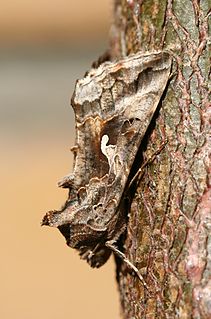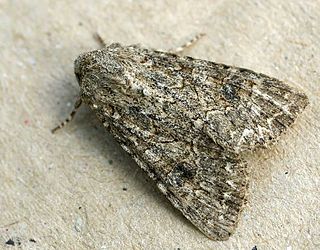
The Noctuidae, commonly known as owlet moths, cutworms or armyworms, are the most controversial family in the superfamily Noctuoidea because many of the clades are constantly changing, along with the other families of the Noctuoidea. It was considered the largest family in Lepidoptera for a long time, but after regrouping Lymantriinae, Catocalinae and Calpinae within the family Erebidae, the latter holds this title now. Currently, Noctuidae is the second largest family in Noctuoidea, with about 1,089 genera and 11,772 species. However, this classification is still contingent, as more changes continue to appear between Noctuidae and Erebidae.

Noctuoidea is the superfamily of noctuid or "owlet" moths, and has more than 70,000 described species, the largest number of for any Lepidopteran superfamily. Its classification has not yet reached a satisfactory or stable state. Since the end of the 20th century, increasing availability of molecular phylogenetic data for this hugely successful radiation has led to several competing proposals for a taxonomic arrangement that correctly represents the relationships between the major lineages.

Xestia is a genus of noctuid moths. They are the type genus of the tribe Xestiini in subfamily Noctuinae, though some authors merge this tribe with the Noctuini. Species in this genus are commonly known as "clays", "darts" or "rustics", but such names are commonplace among Noctuidae. Xestia moths have a wide distribution, though they most prominently occur in the Holarctic.

The Calpinae are a subfamily of moths in the family Erebidae described by Jean Baptiste Boisduval in 1840. This subfamily includes many species of moths that have a pointed and barbed proboscis adapted to piercing the skins of fruit to feed on juice, and in the case of the several Calyptra species of vampire moths, to piercing the skins of mammals to feed on blood. The subfamily contains some large moths with wingspans longer than 5 cm (2 in).

Acontiinae is a subfamily of the moth family Noctuidae. The taxon was erected by Achille Guenée in 1841.

Plusiinae is a smallish subfamily of the moth family Noctuidae. As the Noctuidae appear to be a paraphyletic assemblage, the Plusiinae may eventually be raised to family status.

Hadeninae is a subfamily of moth family Noctuidae. The limits between this group and the Condicinae and Noctuinae are still not precisely known, with 3 major and partially conflicting revisions since 2006. Some include the noctuid subfamilies Eriopinae and Psaphidinae here as tribes Eriopini and Psaphidini, yet the former are not even recognized as distinct tribe by all sources. Another proposed treatment is to include the group within an expanded Noctuidae.

Acronictinae is a large subfamily of moths in the family Noctuidae.

Drasteria is a genus of moths in the family Erebidae.

Heliothinae is a small subfamily of moths in the family Noctuidae. There are about 400 species described worldwide. They are found predominantly in semiarid subtropical habitats.

The Erebidae are a family of moths in the superfamily Noctuoidea. The family is among the largest families of moths by species count and contains a wide variety of well-known macromoth groups. The family includes the underwings (Catocala); litter moths (Herminiinae); tiger, lichen, and wasp moths (Arctiinae); tussock moths (Lymantriinae), including the arctic woolly bear moth ; piercing moths ; micronoctuoid moths (Micronoctuini); snout moths (Hypeninae); and zales, though many of these common names can also refer to moths outside the Erebidae. Some of the erebid moths are called owlets.

The Erebinae are a subfamily of moths in the family Erebidae erected by William Elford Leach in 1815. Erebine moths are found on all continents except Antarctica, but reach their greatest diversity in the tropics. While the exact number of species belonging to the Erebinae is not known, the subfamily is estimated to include around 10,000 species. Some well-known Erebinae include underwing moths (Catocala) and witch moths (Thermesiini). Many of the species in the subfamily have medium to large wingspans, up to nearly 30 cm in the white witch moth, which has the widest wingspan of all Lepidoptera. Erebine caterpillars feed on a broad range of plants; many species feed on grasses and legumes, and a few are pests of castor bean, sugarcane, rice, as well as pistachios and blackberries.
Max Gaede was a German engineer and entomologist of international fame who described several hundred of new species of Lepidoptera, mainly African Noctuidae.

Pseudohadena anatine is a moth of the family Noctuidae. It is found on the Ustyurt plateau in south-western Kazakhstan.

Pseudohadena gorbunovi is a moth of the family Noctuidae. It is found on the Ustyurt plateau in south-western Kazakhstan.

Pseudohadena evanida is a moth of the family Noctuidae. It is found in Central Asia, including Kazakhstan.

Pseudohadena magnitudinis is a moth of the family Noctuidae which is endemic to Iran.
Emilio Berio was an Italian entomologist and lawyer.
Pseudohadena vulnerea is a species of cutworm or dart moth in the family Noctuidae. It is found in North America.

















